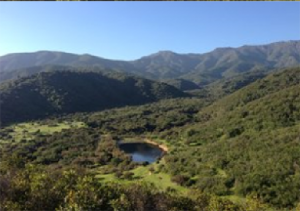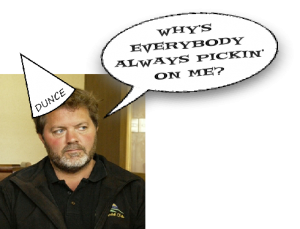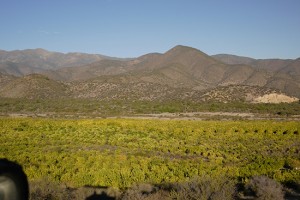On Aug 28 2014, just a couple of days after the first internet articles appeared (see here, and here) marking the public beginning of Ken Johnson’s long, slow journey to his very own third world prison cell, a real estate agent in Chile began his blog post with these words:
“As I’m sure many of you know, for the past couple of years there’s been a lot of talk about a project aimed at American ‘libertarians’ on a property close to Santiago, in Curacaví. The name? Galt’s Gulch Chile, after Ayn Rand’s novel.
“When I first heard of this project, my initial reaction was, ‘Curacaví? Where on Earth are they planning to get the water rights for a project of this size? The valley is basically dry.’”
Dry summer mountains overlooking the Lepe lemon orchard.
And dry it is, although Johnson and Lepe’s former owner, Guillermo Ramirez, continue to dispute this assessment.
Whenever Johnson is asked to quantify the amount of water available for the GGC project, he responds that there are 420 liters per second (l/s) subterranean water rights from 53 wells (sometimes deep wells), and 216 l/s (sometimes 340, sometimes 360 l/s) surface water rights. He shares water quality reports from 2010. He claims that subterranean water rights in the area are selling for $20,000 per l/s (sometimes $25,000 per l/s), making GGC’s more valuable than the entire Lepe/Las Casas property based on the purchase price. He will assure you there is more than enough water for the residential area and 100 hectares of agricultural operations, allowing for the expansion of hectares under cultivation at the farm, with water rights left over to sell. Selling “excess” water rights is how Johnson proposes to raise capital to recover from his astoundingly feckless management of the project.
Note that he never answers the question.
For his part, Ramirez feigns astonishment at all the hubbub. “[It] is  hard to understand, that clever people participating on a winner project, knowing all the facts about it, and even more, having visited the site and saw it, with their own eyes are unable to discuss the best way to arrive at a happy end.”
hard to understand, that clever people participating on a winner project, knowing all the facts about it, and even more, having visited the site and saw it, with their own eyes are unable to discuss the best way to arrive at a happy end.”
But do we know all the facts about Lepe/Las Casas? We investors contend that we don’t–in no small part due to Ramirez’s misrepresentations–and that is the crux of this dispute.
Johnson did not perform adequate due diligence on the water resources before the August 13, 2013 closing on the property. That would be bad enough if he hadn’t been equally negligent with the first property he purchased less than a year before and that he abandoned due to lack of water. But of course, it gets worse because he was also well aware of legitimate concerns that Ramirez was making misrepresentations.
- As early as July, two GGC sales people pointed out that owning water rights is not the same as having water.
- Also at that time, Berwick’s advisor, Chris Serin, warned that the dead and dying avocado trees in the “orchard” were evidence that at least more due diligence was necessary. He recommended against the Lepe purchase. As an aside, Ramirez claimed that this orchard is water starved due to the 2010 earthquake. However, we have satellite evidence that the orchard was water stressed beginning in 2007. He probably stopped irrigation which could have been due to lack of water or possibly the cost and he then lied about it to Johnson and the investors.
- By August 6, 2013, Johnson heard that a neighbor and life-long resident in the valley believed the available water was insufficient for the development.
Johnson’s response to these critical warnings was predictable to anyone familiar with his modus operandi. He dumped the sales people, stonewalled and demonized Serin, and demanded that GGC’s lawyer intimidate his neighbor. To this day, without testing to size the aquifer, he claims there is not only sufficient water, but excess water.
Johnson did pay for a hydrology study that apparently was delivered to him after he closed on the sale. Read it here. Here are the salient points:
- “A maximum sustainable exploitation of 484.41 l/s, equivalent to 15,276,354 m3/year, has been estimated for this aquifer, which does not cause effects beyond the limits established for surface water courses. The committed demand (granted water rights) to June 30, 2010, was 35,512,119 m3/year [1,126 l/s], considerably higher than what was defined as sustainable.” In other words, there are more than twice the water rights than the amount of water that can be sustainably drawn, according to government estimates as of 2010. Note that Chile, like California, has been experiencing a multi-year drought since then.
- “Ongoing exploitation of the project’s water rights is not sustainable according to the parameters of the DGA [Departamento General de Aqua]. The sustainable flow is most probably of the order of one third of the water rights legally granted.” That would make GGC’s share 140 l/s. However, how would a reduction in exploitation of the water rights be established or enforced?
- “All the water rights reviewed have an associated collection point on site, which can apparently provide water. It is unknown whether all the collection points are capable of providing the flow granted by law.” That is, it’s not clear how much surface water is available. It could be less than the permitted 216 l/s (or 340, or 360).
- “The use of the rights associated to the basin of the Puangue Stream, which most probably interfere with surface flows, could generate conflicts with users of surface water downstream. (In dry years the surface water could disappear and surface water users would then blame the underground water users located upstream).” Without careful management of resources, water wars are a possibility.
- Three of the four wells tested have high coliform counts.
- “The sale value of each liter/second of underground water in the basin is approximately UF 62 [or US $2,250].” Johnson is off by an order of magnitude on valuing the water rights.
Johnson did not reveal any of these findings to GGC investors. Indeed, despite this report, he continued to flog the avocado orchard in his marketing literature and presented plans for expanding into water-sucking row crops.
When the investors finally heard that there may not be sufficient  water beneath Lepe, and shortly thereafter Johnson announced that he intended to sell “excess” water rights, their panic was palpable. Johnson proposed to use the water rights money for paying the final real estate payment plus late penalties, for pursuing subdivision approvals and for paying refunds. He claimed he could raise a cool $6 million. Recall that the purchase price for Lepe/Las Casas was $6.8 million.
water beneath Lepe, and shortly thereafter Johnson announced that he intended to sell “excess” water rights, their panic was palpable. Johnson proposed to use the water rights money for paying the final real estate payment plus late penalties, for pursuing subdivision approvals and for paying refunds. He claimed he could raise a cool $6 million. Recall that the purchase price for Lepe/Las Casas was $6.8 million.
Knowing that Johnson did not perform the required due diligence and calculating that water sales would not raise the necessary funds to pay off GGC’s prodigious debts, investor Josh Kirley moved to prevent Johnson from leaving the property dry and the project insolvent. He petitioned the courts to grant an injunction preventing water rights sales.
Johnson claims that the injunction is the reason the project is stalled, but this is hardly the case. To the contrary, it may be the single most important action in ultimately saving GGC, since it ensures that the water rights remain for the community’s use.
At the time of the injunction, Johnson had succeeded in alienating all but two very inexperienced sales people who lived at the hacienda  like indentured servants. He had little marketing reach having cheated Berwick out of his share of GGC. Sales were non-existent. He had fired his farm manager for refusing to be a yes man. He had lost ownership and control of the real estate holding company, Inmobiliaria Galt’s Gulch SA, and the real estate to his swindler of a partner, Mario Del Real. His investors, becoming more and more frustrated, began to see through his many attempts at covering up his incompetence and fraud. Johnson had run out of other people’s money and everyone’s patience. These are the reasons GGC is stalled, not the injunction.
like indentured servants. He had little marketing reach having cheated Berwick out of his share of GGC. Sales were non-existent. He had fired his farm manager for refusing to be a yes man. He had lost ownership and control of the real estate holding company, Inmobiliaria Galt’s Gulch SA, and the real estate to his swindler of a partner, Mario Del Real. His investors, becoming more and more frustrated, began to see through his many attempts at covering up his incompetence and fraud. Johnson had run out of other people’s money and everyone’s patience. These are the reasons GGC is stalled, not the injunction.
The obvious question now is, Is there enough water? The investors think so, but can’t be sure. We have been told that when the water rights were granted, the area was wetter than today. Streams on the property that used to flow year round are now seasonal. And the avocado orchard failed for lack of water. Still, these observations don’t quantify the water underground.
If the 140 l/s number suggested from the hydrology report is used as a good estimate of water availability, and it’s agreed that the existing citrus orchards require 50 l/s, 90 l/s remain for the rest of the project. Since residential use requires much less water than agricultural use, it appears that a development of several hundred houses may be possible.
On a related note, Johnson left yet another land mine for the investors having to do with water resources. His lack of due diligence extended to residential wastewater, since little study or planning has been done with respect to its treatment and discharge.
Johnson was willing to fly blind because he was using other people’s money. We investors don’t have that luxury. Quantifying the size of the aquifer is our first priority after obtaining ownership of the project. It should have been Johnson’s first priority before agreeing to blow $6.8 million. For that material omission alone, he should be behind bars.
By the way, you might have noticed that sometimes Johnson says that GGC is stalled due to the water rights injunction (dated Oct 2014) as mentioned above; sometimes says it’s stalled due to the “orchestrated chain of refund requests” of April 2014 that never happened; and other times says it’s stalled due to the nefarious plot *eye roll* between former employees, us investors and Chilean swindler Mario Del Real. We guess Li’l Kenny Johnson has trouble keeping his lies straight.


